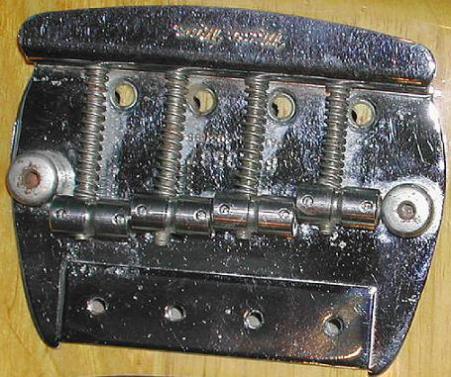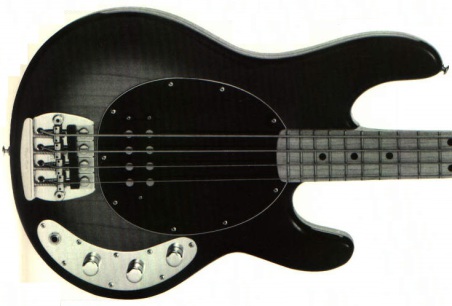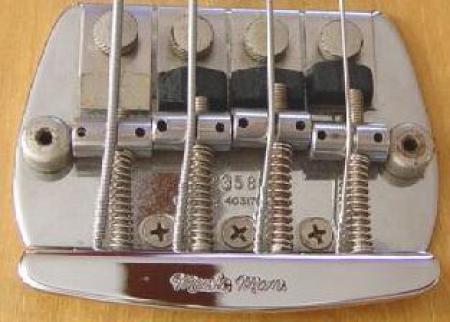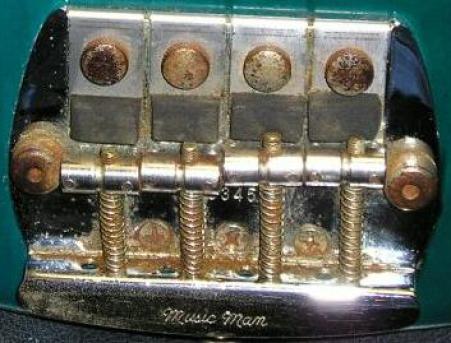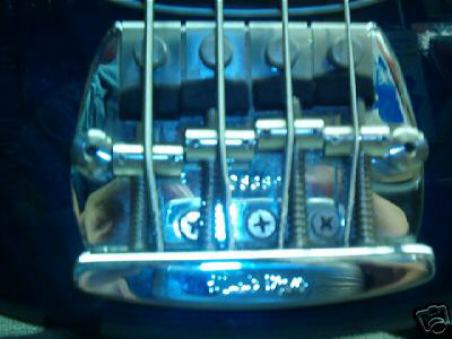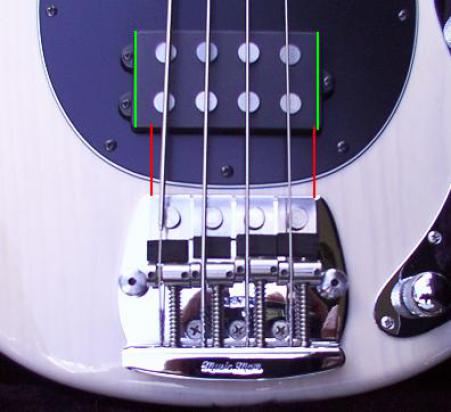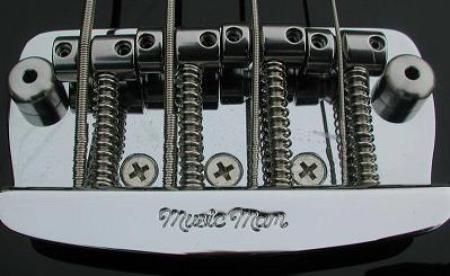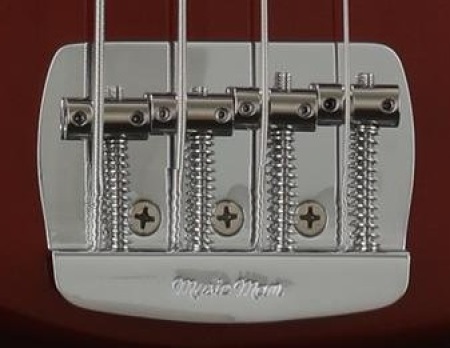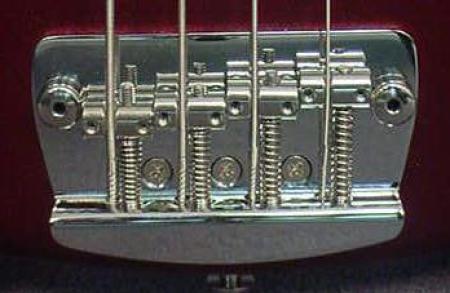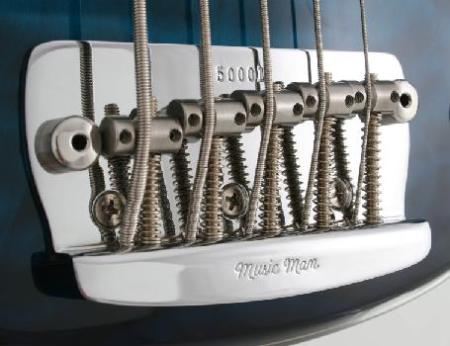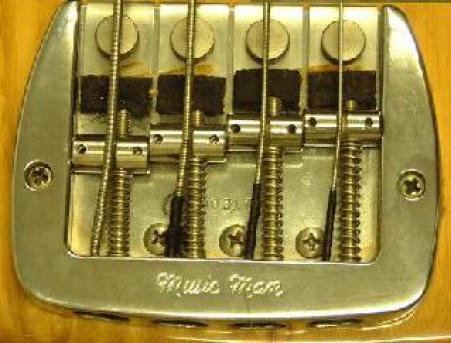Formerly MUSICMANBASS.ORG
BRIDGES Pre-EB & EB
Pre-EB SR4. EB SR4. USA SUB. Classic SR4. 40th Anniversary "Old Smoothie".
EB SR5. Pre-EB Sabre.EB Sabre. Classic Sabre. Sterling 4.
Pre-EB SR4 (June 1976 - Dec 1983)
1976 (June).
B001008 (June 1976).
B001024 (Aug 1976).
Bridge B001008 (top) is positioned further back towards the end of the body when compared to the position of bridge B001024. It would seem that the forward intonation adjustment for the G saddle was taken to its very limit. Consequently the bridge is moved slightly forward to compensate. Bridge-repositioning appears to have taken place very early.
1976 - Circa late 1978.
1976 bridge.
1977 bridge.
1978 bridge.
1) Strings through
body.
2) Adjustable string mute screws centred directly under each string and measure 7/16" diameter.
3) Hollow (barrel) saddles with height adjustment hex screws that
only protrude beneath saddle but not througth the top.
4) String grove centred on saddles.
5) Patent pending stamp.
Height adjustment screws on the saddles only protrude from underneath. The design of barrel saddles prevents the
adjustment screws protruding from the top as they would with solid saddles.
Due to the positioning of the string-through-body holes on the bridge, the strings are forced to partially wrap around the intonation screws.
Serial numbers are located on the neck plate and not the bridge. The serial are prefixed with a "B" and followed with six digits.
Circa late 1978.
Bridge from a Bass with a late 1978 body and
early Jan 1979 neck.
The new bridge positioned on an older body
showing the new string-through
hole positioning on the bridge.
From Oct 1982 Music Man Catalogue depicting the
Strings-through-body bridge.
Same as the previous 1976 to circa late 1978 bridge but:
1) Serial number is now deleted from the
neck plate and relocated to the bridge between the saddles and bridge tail.
2) "MUSIC MAN" now stamped on bridge tail.
3) String through holes offset to the left.
Although this new bridge appeared circa late 1978, the previous earlier bridge can be found on Basses up to the end of
1978.
The string-through holes now prevent the strings having contact with the intonation screws. However, the strings now form a
slight angle from the repositioned holes to the saddles.
Circa 2nd half 1982. Introduction of the Top Load Bridge.
1983 bridge.
Side view of a 1982 top-load bridge showing the
hollowed (barrel) saddle.
Same as the previous circa late 1978 bridge but:
1) Strings now top-loaded as opposed to
strings through the body.
2) Three anchor bolts added to rear of bridge.
Due to the strings now anchored from the rear of the bridge along with the string grooves remaining centred on the saddles, the strings now form a more noticable angle from their anchor points to the saddles.
CUTLASS 1 BASS [Sting Ray with graphite neck] (1983)
Bridges used can be either string-through-body bridges or top load bridges. Serial numbers are the same as used for the Pre-EB Sting Ray.
EB SR4 (March 1984 - Current)
1984 - Circa late 1988 or early 1989.
Three bridge types used during this period:
Type 1 (1984 to circa 1986-87)
Pre-EB bridge used on a circa 1986 EB Bass
with
Pre-EB serial number B023586.
Old stock Pre-EB top load bridges with Pre-EB 6 digits serials prefixed with a "B" were used on early Ernie Ball Basses up to (and including) 1988. String saddles are hollow (barrel). Thumb screws remain 7/16" diameter with a flat top.
Type 2 (Jan 1987 to circa late 1988 or early 1989)
Circa 1987 EB style bridge. Serial 25359.
Ernie Ball introduced their own bridge styled on the previous Type 1 Pre-EB bridge. This bridge introduced Ernie Ball's own unprefixed 5 digit serials "2xxxx" and latter, in 1988 (for approx 1 year concurrently), its own "B027xxx" serials. NOTE that tne B027xxx serials are NOT Pre-EB serials and can be found on the Ernie Ball serial number finder by deleting the "B" prefix. For example: details of B027186 can be found on the serial finder by deleting the "B" and entering the serial number as "027186". The serial number finder does not record Pre-EB serial numbers nor Pre-EB serial numbers used on early Ernie Ball Basses.
A Pre-EB bridge has patent numbers beneath the serial. The Ernie Ball bridge has no patent numbers
below the serial
As with Type 1, the string saddles remain hollow (barrel) and
thumb screws remain 7/16" diameter
but now have a domed (or rounded) top.
Type 3 (circa 1987 to circa late 1988 or early 1989)
Smaller thumb screws. Serial 25830 from bass
with
neck and body both dated Aug 1987. The hollow
(barrel) saddle can be seen on the G string.
The same as Type 2 above but new mute thumb screws introduced which are smaller in diameter at the top: 3/8" as opposed to the previous 7/16" diameter. NOTE that the screw shaft is the same diameter and has the same thread as the previous thumb screws. It is only the round top of the screw that has changed in diameter. Both screws are interchangable on all bridges (Pre-EB and Ernie Ball) with the adjustable mutes.
Note that during this 1 year period either the earlier larger or this new smaller diameter topped thumb screws can be found on either the Ernie Ball 5 digit serial number bridge or the Ernie Ball "B027xxx"seriall number bridge.
As with Type 1, and Type 2, the string saddles remain hollow (barrel).
Larger thumb screws. 1987 Bass. Serial 25345.
Smaller thumb screws. Serial B027673 from
bass with
a 1987 neck and 1988 body. Although not visible,
the string saddles are hollow (barrel).
NOTE: Pre-EB bridges (with the "B" prefixed six digit serials) have patent numbers underneath the serial. The similar-styled Ernie Ball bridge (with its own un-prefixed five digit serials and own B027xxx serials) do not have patent numbers underneath.
Circa late 1988 (or early 1989) - Circa 1992.
Front and side view of Bass serial 28305
(date of birth
22 March 1989). The solid saddle can be seen on
the E string in pic directly above.
Unprefixed serial bridge from 1991. Front
and side view (solid saddles).
Same as Type 3 bridge (above) but:
1) Saddles are now solid allowing
height adjustment screws to protrude through both top and underneath screw holes. (The previous hollow saddles (barrel) only allow adjustment screws to protrude from the
underneath).
2) The smaller diameter thumb screws are now standard (even on 1988 bridges using the Pre-EB "B" serial numbering).
As this bridge now appears exclusively, the Pre-EB "B" prefixed serials cease to be used by the end of 1988. Only the five digit serials are used from this point on.
Above two pics showing bridges from this period
that are wrongly re-assembled.
1992 - Circa 1994 "Flea Bridge".
Both pics from a 1994 Bass. Commonly
referred
to as a "Flea Bridge".
Began to appear on some Basses as early as Apl 1992. By early 1993 most Basses appear to have this style bridge.
Same as for circa late 1988 (or early 1989) to circa 1992 but:
1) Although the saddles remain solid, the
string grooves are now offset to the left of centre (similar to the SR5 Bass at that time which never had grooves centred on the saddles). The result is that the strings move to the left of the mute
thumb screws. Accordingly, the acute string angle from the bridge tail to the saddles ceases to exist.
2) Saddle grooves cease to be uniform and are cut for string gauge.
"This bridge arrangement was originally designed specifically for "Flea", for the purpose of ensuring straight string pull across the bridge saddle, rather than the "bend" that is present on the earlier models. Also the groove in the saddles is sized for each individual string, and is deeper, to make sure the string could not be pulled out with his aggressive style of playing." (Per EB).
Due to the string grooves on the saddles being offset to the left of centre, the bridge is offset and moved to the right of the pickup (closer to the control plate) to allow the strings to remain centred over the pickup pole pieces. If the bridge remained in its former position, the strings would have been offset to the left of the pole pieces. This style bridge was common during the period 1992 to 1994 (or perhaps longer depending on depletion of stock).
Circa 1993 - 1996 "Trans Bridge".
From a 1995 Bass.
Commonly referred to
as a “Trans Bridge”.
From a 1996 Bass.
Same as for circa 1992 to circa 1994 ("Flea" Bridge) but:
Mute assembly removed completely and 4 hex bolts placed in the holes previously occupied by the mute thumb screws. NOTE: Again, the shaft diameter and shaft thread remains the same as the previous thumb screws.
It was decided to remove the mute assembly to prevent hand injury.
An old mute assembly
kit with fitting instructions
(EB part number "M05114"). Kits are no
longer stocked by Ernie Ball. The
assembly also fits Pre-EB
Sting Ray Basses.
Ernie Ball offered after market kit sets for those wishing to install the mute assembly to the Trans Bridge. The kits included hex bolts and a hex wrench (allen key) to use specifically for adjustment of the mutes. This would explain why some bridges have the mute assembly along with hex bolts rather than thumb screws.
1996 - Early 1998 "Down-Sized Bridge".
20th Anniversary Bass (1996).
1996 bridge from a 20th
Anniversary Bass (above).
Note that the "A" prefixed serial number
is still located on the bridge.
Same as for circa 1993 to 1996 ("Trans"
Bridge) but:
1) The area of the bridge previously occupied by the mute assembly and hex bolts is now completely removed.
2) The previously unprefixed five digit serial number now becomes prefixed with an "A" for the 20th Anniversary Bass. At a latter stage the"B" and "D" are used. The prefix "L" is also introduced
for left handed Basses (1996 is the first year for left handed Basses).
It was this model that introduced the “Down-Sized” bridge. In 1996 these bridges ran concurrently with the Circa 1993 to circa 1996 ("Trans" Bridge) above.
Putting aside serials consisting of 6 digits with a prefixed "B" (as found on Pre-EB bridges used on early EB Basses), all serial numbers up to this point (1996) consist of 5 unprefixed digits located on the bridge.
The down-sized bridge introduced the first
prefixed 5 digit serial numbers still located on the bridge. The 20th Anniversary serials are prefixed with an "A". Left handed Basses are prefixed with an "L". Other Basses (up to 1998) have
"B" and then "D" prefixes. The "A" serials apply to the 20th Anniversary Bass only. All serials are located on the bridge.
The "B" prefixed 5 digit serials are not to be confused with the earlier "B" prefixed 6 digit serials used from 1985 to 1988 (as found on Pre-EB bridges used on early EB
Basses).
A circa 1997 bridge.
Unknown whether this particular
serial is prefixed with a "B" or a "D".
1998 - Late 1998 (or early 1999).
The older bridge (left)
compared with the newer style
1998 bridge (right).
A larger pic of the new bridge used in
the comparison
above. E04246 Aug/Sep 1998.
Same as for 1996 to early 1998 ("Down-sized" Bridge) but:
1) String grooves move closer to the
intonation screws.
2) The three anchor screws at the tail of the bridge are shifted to the left (closer to the intonation screws) and are more centred on the bridge plate.
3) The serial number is deleted from the bridge and relocated to the neck plate (including left handed "L" Basses).
The neck plate serial is now prefixed with
an "E" (and "L" for left handed Basses). The relocation of the "E" serial appears to coincide with the new neck plate logos. Saddle grooves remain cut to string gauge.
Note that the three anchor bolts are shifted to the left and become more centred on the bridge plate (closer to the intonation screws). The
saddle widths remain the same ie 3/4 inch end to end. Also note the new position of the string grooves.
Although this bridge appears to have been featured for a limited time, examples may be found in 1999.
Circa late 1998 (or early 1999) - Circa May 2003.
December 2000 or Jan 2001.
July/Aug 2002.
Same as for 1998 to circa late 1998 (early
1999) but:
1) Saddle screw holes are counterbored at the top and are larger in diameter at point of screw entry (same or slightly larger in diameter to the holes on the anchor bolts at each side of the bridge).
Saddle diameter and width remains the same (3/4 inch).
2) Saddle grooves remain cut to string guage.
Circa May 2003 - 2018.
E36586 Apl/May 2003.
Same as for Circa late 1998 (early 1999) to circa May 2003 but:
Saddle grooves are all the same size and are "V" cut. These saddles co-incide with the release of the Bongo Bass in mid 2003.
Sting Ray Special 2018 - Current.
The side bolts are now deleted from the bridge.
String saddles are the hollow barrel type.
To reduce weight the large anchor bolts that are normally placed on each side of the saddles have been deleted resulting in a narrower, but slightly longer, bridge. Bridges are either chrome or black depending on color scheme. Five digit serials are located on matching neck plates and prefixed with an "F".
SUB 4 & 5 (USA) 2003-2006.
2003 SUB 4 bridge X00394. The
string groves on the saddles
are cut to string guage.
2004 SUB 4 bridge
X05860. String grooves on the
saddles are now cut uniformly.
SUB 5 bridge X07344 (late 2003 early 2004).
String grooves cut uniformly.
Note deletion of "Music Man" logo from bridge tail. Five digit serial numbers prefixed with an "X" are recorder on the rear of the headstock.
Classic Collection 2010 - Current.
Similar to the Pre-EB string-through-body bridge from late 1978 through to late 1982. Hollow barrel type saddles. Serials located on the bridge and have a "B" prefix followed by six digits starting at 05. For example B05xxxx.
40th Anniversary "Old Smoothie"
2016 - Current.
The bridge tail is blank. The serials are
located on the neck plates.
Hollow barrel type saddles. The bore is larger in diameter
than on the Classic Collection saddles above.
Based on Sterling Ball's Pre-EB SR4 B001026 given to him by Leo Fender. Serials are located on the neck plates and not the bridge. These Basses were being built at a time when the Ernie Ball serial prefixes were changing. Consequently, Basses can have either either an "E" or a "C" prefixed five digit serial number.
EB SR5 1987 - Current
1987.
Serial 50001
The first 10 original 1987 SR5 bridges (which were set aside at that ime) are now used on the 10 (only) 2007 "Ball Family Reserve" 20th Anniversary SR5 Basses.
A 1989 SR5 bridge.
An unprefixed five digit serial number is located on the bridge from 1987 to 1998. However, in 1996 (introduction of the left handed Basses) the five digit serial became prefixed with an "L" (also located on bridge).
Circa late 1994.
From a Nov 1994 SR5.
Note that saddle grooves are now cut to string guage (compare with previous picture). Unknown exactly when this change took place.
1998.
2000 SR5 bridge.
The unprefixed 5 digit serial was deleted from bridge and relocated to the neck plate with an "E" prefix in 1998. The pre-existing "L" prefixed serial for left handed Basses also moved to the neck plate. Saddle grooves remain cut to string guage.
Circa 1999.
Piezo option from c.1999 and discontinued 2015.
Circa Mid 2003.
2004 SR5 bridge.
The string grooves are "V" cut and are now uniform in size with each other.
Sting Ray 5 Special 2018 - Current.
String saddles are the hollow barrel type.
To reduce weight the large anchor bolts that are normally placed on each side of the saddles have been deleted resulting in a narrower, but slightly longer, bridge. Bridges are either chrome or black depending on color scheme. Five digit serials are located on matching neck plates and prefixed with an "F".
Pre-EB SABRE (Mid 1979 - Dec 1983)
SABRE Mid 1979 - Dec 1983.
Sabre bridge used during the Pre-EB period.
1) Strings are top-loaded (never
through the body).
2) Hollow (barrel) saddles with centred string grooves.
3) Mute thumb screws centred under strings.
4) Three anchor bolts added to rear of bridge.
5) “MUSICMAN” stamped on bridge tail.
6) Serial located on the bridge between saddles and bridge tail.
7) Serials have a “C” prefix.
CUTLASS 11 BASS [Sabre with graphite neck] (1983 - 1984)
These Basses use the normal MM Sabre bridge as above. Serial numbers are the same as used for the Pre-EB Sabre. As with the Cutlass 1 Basses, although necks are dated 1983 or 1984, bodies can be dated earlier.
EB SABRE (1984 - 1991) & (2013 - 2015)
The Pre-EB Sabre bridge (above) was used on very
early EB Sabre Basses.
Sabre 1984 - 1991.
Some very early Sabres used Pre-EB Sabre bridges (as in pic directly above). Consequently, these early Basses still had the Pre-EB Sabre serial numbers ("C00xxxx").
Subsequently Sting Ray bridges were used on the Sabres. Bridges are the same as for the SR4 bridge progression from 1984-1991 (see above). Consequently the early C00xxxx were replaced with both B00xxxx and unprefixed five digit serials up to 1988. Only the unprefixed five digit serials were used after 1988 until production ceased in 1991.
Classic Collection Sabre 2013 - 2016.
Classic Sabre bridge.
Strings are top loaded as opposed to the Classic Sting Ray which are strung through the body. Similar to the Pre-EB top load bridge from late 1982. Hollow (barrel) saddles. Serials located on bridge and have a "B" prefix and six digits starting at 05. For example B05xxxx.
STERLING 4 (March 1993 - Current)
Muted "Flea" bridge from a 1993 Sterling Bass.
The Sterling 4 bridges are the same as for the SR4 bridge progression from 1993 onwards (see above).
As with the SR4, Sterling serial numbers were initially unprefixed 5 digit numbers but then became prefixed in circa 1996 when the bridge was
down-sized eg "B" and "D" prefixes (refer to SR4 above). Likewise, the serial moved to the neck plate in 1998 BUT prefixed with an "F" and not the SR4 "E". The "L" prefix is also used
for left handed Sterling Basses.
Home About
Musicmanbass.global & Contact 1978 Hangtag
Manual Serials Pre-EB Sting
Ray Serials EB Sting Ray 4 Serials Pre-EB Cutlass 1 & 11
Serials Pre-EB Sabre Serials EB Sabre Serials Sting Ray 5 Serials
Sterling Serials American SUB
SR4 PUPs and Preamps Pre-EB & EB (Part
1)
SR4 PUPs and Preamps Pre-EB & EB (Part
2) Bridges Pre-EB &
EB Neck Plates Pre-EB & EB
Headstock Logos (Part 1) Headstock Logos (Part 2) Bass Collecftions No.1
Bass Collections
No.2







